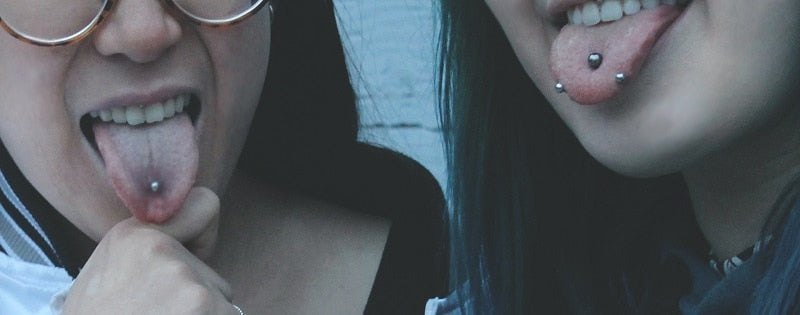Many of our piercing artists in both Toronto & Vancouver and Markham have noticed a lot of confusion around dermal piercings of late. As these kinds of piercings are quite different than what you might expect from a regular piercing, we wanted to take the time to explain how a dermal piercing differs from a regular piercing and how it can often be a much more effective choice for a piercing.
There’s more than one type of piercing?
Before we dive into what dermals are, let’s start with what is often defined as a “regular” or “surface” piercing. Surface piercings involve passing a bar or flexible piece of plastic through two, close together, points of skin.
The best way to visualize this is with a pen and some paper. Imagine the paper as your skin; now punch a hole through it with the pen and then another so that the front and back of the pen are now on the same side of the paper. This is a surface piercing. Jewellery is then attached to each end of the bar however, only specialized jewellery can do this.
As a result of this technique, surface piercings can put a lot of strain on your skin. The average lifetime of a surface piercing is only 1–2 years before your body begins to reject the piercing. Rejection is when your body pushes the piercing toward the surface, often causing migration or complete loss of the jewelry—similar to how your body expels a splinter.
Surface piercings also have a number of other limitations including:
Flat Surfaces: Surface piercings work best on curved areas of the body. Flat areas increase tension, which leads to faster rejection. Think back to the pen and paper example—curvature reduces the strain.
Healing Time: Due to the tension and trauma caused to the skin, surface piercings often take longer to heal. On average, it may require 3 months of consistent aftercare to stabilize the piercing.
What about Dermal Piercings?
Dermal piercings are made up of two components: the anchor and the jewelry. Each is a “single-point” piercing, meaning there’s no bar connecting two exit holes. This makes them highly versatile and ideal for areas that wouldn’t work with traditional piercings. You can place dermals almost anywhere on the body, and each one functions independently.
What about the pain? Aftercare?
Because dermals don’t require tension across the skin like a bar, the procedure often causes less inflammation. That means reduced pain during and after the piercing. Healing tends to be quicker as well. Although rejection can still occur, it's less likely due to the smaller footprint of the jewelry base.
When should I consider a Dermal Piercing?
If you've struggled with rejection, healing, or placement issues from other piercings, dermals could be a better option. Here’s what you should know before booking:
Cost: Dermal piercings often cost more due to the experience required and the specialty tools involved.
Jewelry Quality: Since dermals can last for years, high-quality jewelry is essential. We recommend implant-grade titanium for safety and longevity.
Maintenance: Even though dermals are more stable, they still require proper cleaning and care—especially during healing. Avoid pulling or snagging on clothing.
Consultation: Everyone's skin reacts differently. Our artists will assess your anatomy and goals to recommend the right piercing type. You can book a consultation online at any of our locations.
We also carry a complete range of piercing aftercare products in-store and online to help you maintain a healthy piercing. Our trained piercers are available seven days a week in Toronto, Markham, and Vancouver. Book your appointment now and let us help you choose what works best for your body.




